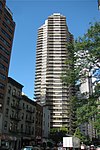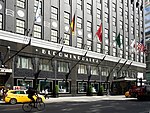Treadwell Farm Historic District

The Treadwell Farm Historic District is a small historic district located on parts of East 61st and East 62nd Street between Second and Third Avenues, in the Upper East Side neighborhood of the borough of Manhattan in New York City. Designated by the New York City Landmarks Preservation Commission on December 13, 1967, making it one of the first historic districts in the city, it is primarily made up of three- and four-story brownstone residences constructed in the middle- to late- 19th century. It also includes the Church of Our Lady of Peace, Trinity Baptist Church, and several turn-of-the-century apartment buildings, and is notable for the general uniformity of the heights of the houses and the style of the architecture, as well as the overall character and charm of the neighborhood.
Excerpt from the Wikipedia article Treadwell Farm Historic District (License: CC BY-SA 3.0, Authors, Images).Treadwell Farm Historic District
East 61st Street, New York Manhattan
Geographical coordinates (GPS) Address Nearby Places Show on map
Geographical coordinates (GPS)
| Latitude | Longitude |
|---|---|
| N 40.763462 ° | E -73.966359 ° |
Address
East 61st Street 153
10065 New York, Manhattan
New York, United States
Open on Google Maps





